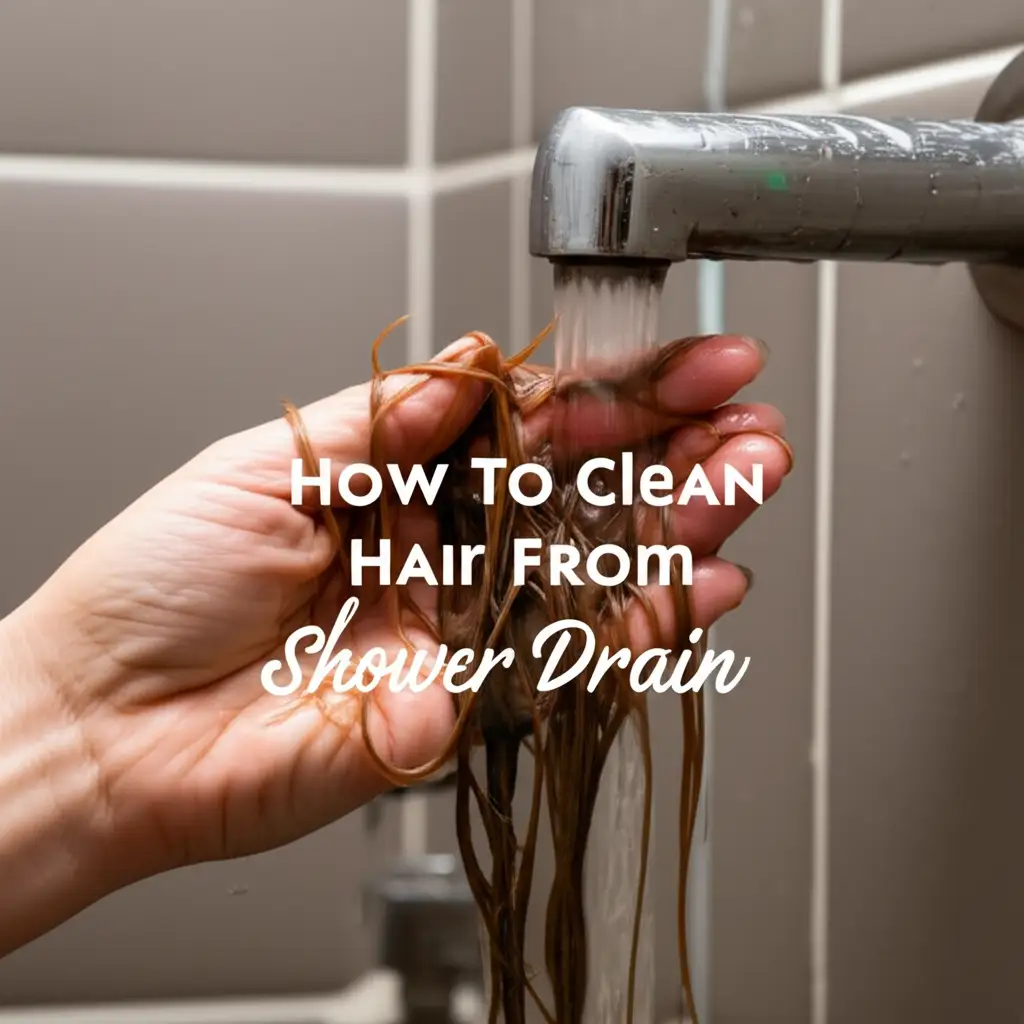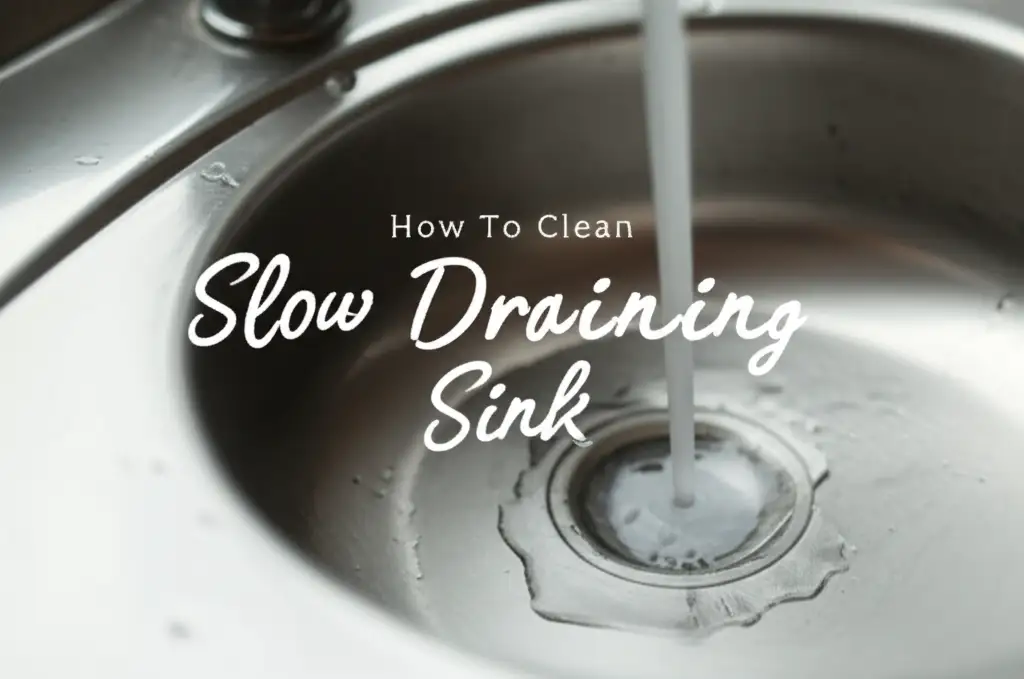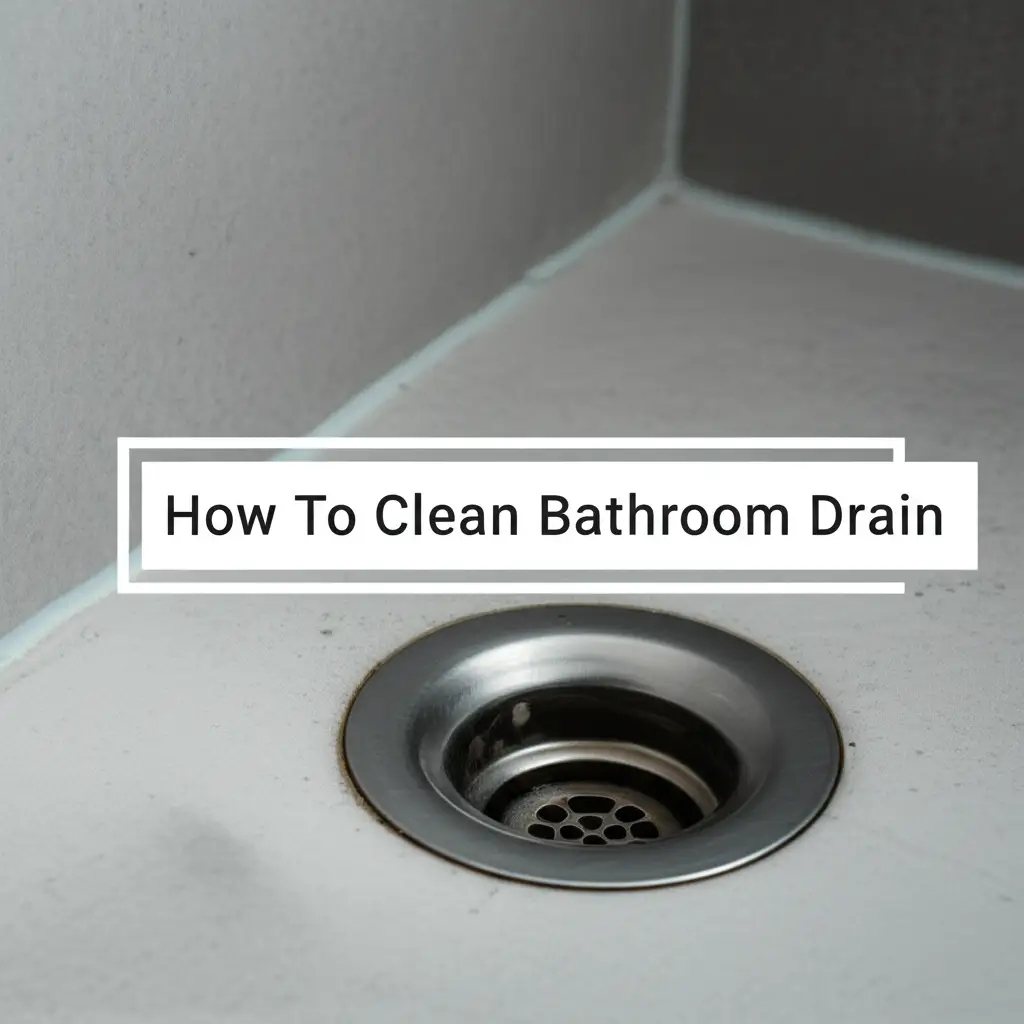· Home Maintenance · 12 min read
How To Clean Hair From Shower Drain

How To Clean Hair From Your Shower Drain Effectively
Has your morning shower turned into a miniature pond? A slow-draining shower often points to one common culprit: hair buildup. Cleaning hair from your shower drain is a necessary task for every homeowner. This problem can seem daunting, but fixing it is easier than you think. I understand the frustration of standing in ankle-deep water.
Hair clogs happen to everyone. They can lead to unpleasant odors and even damage your plumbing over time. Ignoring a slow shower drain often makes the problem worse. In this article, I will share effective methods to clean hair from your shower drain. We will cover everything from simple tools to natural remedies and even how to prevent clogs. Let’s get your drain flowing freely again and restore peace to your bathroom routine.
Takeaway
- Regular removal of visible hair prevents major clogs and ensures proper drainage.
- Simple tools like drain snakes or zip-it tools are highly effective for physical hair removal.
- Natural solutions such as baking soda and vinegar can break down minor hair and gunk buildup.
- Preventative measures like drain covers and regular flushing are crucial for long-term drain health.
- Know when to call a professional plumber for stubborn, recurring clogs to avoid pipe damage.
To effectively clean hair from a shower drain, remove the drain cover. Use a pair of pliers, a hook, or a specialized drain snake tool to pull out visible hair and gunk buildup. For minor clogs, a mixture of baking soda and vinegar can help dissolve the accumulated debris. Always rinse thoroughly with hot water after any cleaning method.
Understanding the Hair Clog Problem in Your Shower
Hair is a major culprit for slow shower drains. Every time you wash your hair, loose strands go down the drain. These strands do not just disappear. Instead, they catch on rough spots or existing debris inside the drainpipe. This starts the formation of a hair clog.
Soap scum, body oils, and grime also contribute to this problem. They stick to the hair strands, creating a sticky, matted mess. This mixture becomes increasingly solid over time. It forms a stubborn blockage that restricts water flow. You will notice your shower taking longer to drain. Standing water around your ankles is a clear sign.
Ignoring these early signs is not a good idea. A small hair clog can grow into a complete blockage. This can lead to serious plumbing issues. Water might back up into your shower or even other fixtures. Unpleasant, stagnant odors can also start coming from the drain. Regular maintenance helps prevent these bigger problems. It saves you from costly repairs down the line. I always address these issues promptly.
Essential Tools for Shower Drain Hair Removal
Before you tackle a hair clog, gather the right tools. Having everything ready makes the job easier and quicker. You do not need many specialized items. Most tools are common household items. I recommend wearing gloves for hygiene.
First, you will likely need a screwdriver. This is for removing the shower drain cover. Some covers simply lift off, but many are screwed down. A flashlight is also helpful. It lets you see deep inside the drain. Pliers or tweezers are great for pulling out hair near the surface.
The most effective tools for deeper clogs are a drain snake or a plastic zip-it tool. A drain snake is a long, flexible metal coil. It has a small auger or claw at its end. This tool goes deep into the pipe. It grabs and pulls out the hair mass. A zip-it tool is a thin plastic strip with barbs. You insert it into the drain, and its barbs hook onto the hair. Both tools are inexpensive and highly effective. Safety glasses are also wise for protection.
Manual Methods to Clear Hair from Drains
Manually removing hair is often the most effective first step. This method directly pulls out the clog. You avoid harsh chemicals this way. I always start with manual removal for shower drain clogs. It gives you immediate results.
First, you need to remove the shower drain cover. Use a screwdriver if it is screwed down. Many covers simply pry up or twist off. Set the cover aside carefully. Use your flashlight to look down into the drain. You will likely see a matted mess of hair and gunk just below the surface.
Now, put on your gloves. Use pliers, tweezers, or even your fingers to grab visible hair. Pull out as much as you can. For deeper clogs, grab your drain snake or zip-it tool. Slowly push the tool down into the drain opening. Twist it as you push. This helps the tool snag the hair. Once you feel resistance, slowly pull the tool back up. You will bring out a significant amount of hair and grime. Repeat this process several times until no more hair comes out. You can also use these methods for similar issues in other areas, such as when you need to clean gunk out of a bathroom sink drain. Afterward, rinse the drain with hot water to check the flow.
Natural Solutions for Hair Clogs: Baking Soda and Vinegar
Sometimes, a manual pull does not get everything. Or you might have a minor clog that is not fully blocking the drain. This is where natural solutions shine. Baking soda and vinegar offer a safe, eco-friendly way to tackle hair and gunk buildup. I find this method surprisingly effective for minor clogs. It avoids harsh chemicals that can harm your pipes or the environment.
This method works due to a simple chemical reaction. Baking soda is a base, and vinegar is an acid. When mixed, they create fizzing and bubbling action. This reaction helps to loosen and break down the grime, soap scum, and some hair. It pushes the debris further down the pipe. It also helps to freshen up the drain. You can use these natural ingredients for other cleaning tasks too. For example, learning how to clean your shower with baking soda can extend its benefits to your entire bathroom.
Here’s how to use baking soda and vinegar:
- Pour 1 cup of baking soda down the drain. Try to get as much as possible directly into the drain opening.
- Follow with 1 cup of white vinegar. You will immediately see fizzing and bubbling.
- Cover the drain with a stopper or a rag. This traps the chemical reaction within the pipes, making it more effective.
- Let it sit for 30 minutes to an hour. For stubborn clogs, you can even leave it overnight.
- Flush the drain with very hot water. This helps to wash away the loosened debris. Some people use boiling water, but be cautious with PVC pipes as extreme heat can sometimes damage them.
Repeat this process if the drain still feels slow. This method is generally safe for all types of plumbing. It is a gentler approach compared to commercial drain cleaners.
Chemical Drain Cleaners: When and How to Use Them Safely
Chemical drain cleaners offer a powerful solution for stubborn clogs. They work by using strong chemicals to dissolve organic matter. These can be effective when other methods fail. However, I always approach them with caution. They are not a first resort. These products contain corrosive agents. They can damage pipes if used improperly.
There are generally two types of chemical cleaners: caustic and oxidizing. Caustic cleaners, like lye or potassium hydroxide, generate heat. This heat helps break down grease and hair. Oxidizing cleaners, often containing bleach, cause a chemical reaction. This reaction helps break down organic material. Enzymatic cleaners are a gentler option. They use bacteria and enzymes to digest clogs over time. They are safer but work much slower. If you have ever wondered about cleaning black stuff in a sink drain, chemical cleaners might be discussed, but focus here is on hair.
If you choose to use a chemical cleaner:
- Read the label carefully. Follow all instructions precisely. Do not guess.
- Wear protective gear. This includes gloves and eye protection. Proper ventilation is also key. Open windows and turn on the bathroom fan.
- Never mix different chemical cleaners. This can create dangerous fumes or explosive reactions.
- Do not use them after other drain cleaners. This includes natural solutions like baking soda and vinegar.
- Pour slowly and carefully. Avoid splashing.
- Allow the product to work for the recommended time. Do not leave it in longer than specified.
- Flush thoroughly with cold water. This stops the chemical reaction and flushes away the clog.
Chemical cleaners should be a last resort for DIY efforts. Excessive use can corrode pipes. They are also harmful to the environment. If a clog persists after one or two applications, stop. Call a professional plumber instead.
Preventing Future Hair Clogs in Your Shower Drain
Prevention is always better than a cure. Taking a few simple steps can save you from future hair clogs. It keeps your shower drain flowing freely with minimal effort. I incorporate these habits into my routine. They make a big difference in maintaining drain health.
One of the most effective prevention tools is a drain protector or hair catcher. These are inexpensive strainers. They sit over the drain opening. They catch loose hair before it goes down the pipe. You simply remove the strainer after each shower. Then, you can easily pick out the collected hair and dispose of it. This simple device dramatically reduces hair buildup.
Regular flushing also helps. Pouring hot water down the drain after a shower helps wash away loose debris. Once a week, you can flush with boiling water. Be cautious with boiling water, especially if you have older PVC pipes. A safer alternative is a monthly baking soda and vinegar flush. Just like for cleaning, this mixture helps break down minor buildup before it becomes a problem. This preventative flush is similar to maintenance for other drains, like when you clean hair out of a bathroom sink drain.
Lastly, brush your hair before showering. This removes a lot of loose hair that would otherwise end up in the drain. If you have long hair, consider tying it up while showering. These small habits significantly reduce the amount of hair entering your plumbing system. Consistent prevention means fewer clogs and less stress.
Professional Help: When to Call a Plumber for Stubborn Hair Clogs
You have tried all the DIY methods. You have pulled out hair. You have used natural solutions. You may have even tried a chemical cleaner. Yet, your shower drain remains stubbornly clogged. This is when it is time to call a professional plumber. Knowing when to escalate the problem saves you time, frustration, and potential damage. I recommend this step without hesitation if DIY fails.
There are clear signs that indicate professional help is needed. If the drain is completely blocked and water is backing up quickly, it is a serious issue. If multiple drains in your home are slow or clogged, this suggests a deeper problem. The clog might be far down the main drain line. Foul odors that persist despite cleaning efforts can also signal a more severe blockage. These indicate a buildup of decaying organic matter.
A professional plumber has specialized tools and expertise. They use industrial-grade drain snakes or hydro-jetting equipment. Hydro-jetting uses high-pressure water to blast away even the toughest clogs. Plumbers can also perform camera inspections. This allows them to see the exact location and nature of the clog. They can also identify other issues, like damaged pipes or tree root intrusion. Attempting to fix a major clog yourself might push it deeper. It can also damage your pipes. A plumber ensures the job is done correctly and safely. Investing in professional help for stubborn clogs protects your home’s plumbing system long-term.
FAQ Section
Q1: How often should I clean my shower drain? I recommend a quick check and manual hair removal after every few showers. For a deeper clean, perform a baking soda and vinegar flush monthly. This routine maintenance prevents major clogs from forming. It keeps your drain running smoothly.
Q2: Can boiling water truly dissolve hair in a drain? Boiling water alone cannot dissolve hair. Hair is made of keratin, which is resistant to hot water. However, very hot water helps melt soap scum and grease. This can loosen the hair clog, making it easier to dislodge. Use caution with boiling water on PVC pipes.
Q3: Are hair dissolving chemicals safe for all pipes? No, hair-dissolving chemicals are not safe for all pipes. Older metal pipes can corrode. PVC pipes can warp or melt if the cleaner generates too much heat. Always check the product label. It will list compatible pipe materials. Use them sparingly.
Q4: What if the smell from my drain persists after cleaning? A persistent smell after cleaning suggests an unresolved issue. There might be residual organic matter still decaying in the pipes. It could also indicate a deeper clog or even a problem with your P-trap or vent pipe. Consider a professional plumbing inspection.
Q5: Can I prevent hair clogs without using a drain cover? It is difficult to prevent hair clogs entirely without a drain cover. Loose hair will inevitably go down the drain. However, regularly brushing your hair before showering helps. You can also perform weekly hot water flushes. These actions reduce, but do not eliminate, the risk.
Q6: My shower drains slowly but there’s no visible hair. What could it be? If there is no visible hair, the slow drain might be due to soap scum or mineral buildup. Hard water deposits can accumulate over time. Sometimes, the clog is deeper in the pipe. It could also be a problem with the vent system. Try a baking soda and vinegar solution first.
Conclusion
A slow shower drain is a common household annoyance. Hair clogs are the primary cause. I know firsthand how frustrating standing in pooling water can be. Fortunately, you now have the knowledge and tools to tackle this problem effectively. We covered simple manual removal techniques. These are often the most straightforward solutions. We also explored natural methods using baking soda and vinegar. These are gentle on your pipes and the environment.
Remember, prevention is key. Using a drain protector and performing regular maintenance flushes can save you from future headaches. These small habits make a big difference in keeping your shower drain clear.
If you face a stubborn or recurring clog, do not hesitate to call a professional plumber. They have the specialized equipment and expertise to resolve deep issues safely. Take control of your home maintenance. Ensure your shower drain flows freely. A little proactive effort will keep your plumbing in top condition. Enjoy your unobstructed, refreshing showers.
- shower drain
- hair clog
- drain cleaning
- home maintenance
- DIY plumbing
- drain care
- slow drain




